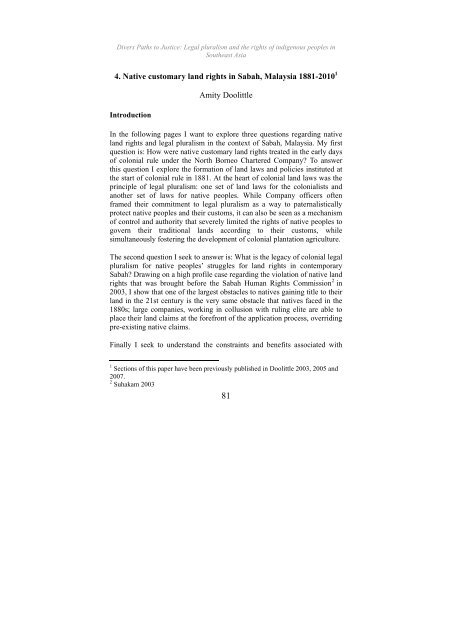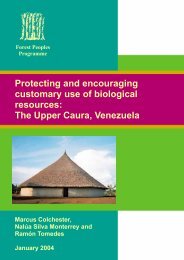Divers Paths to Justice - English - Forest Peoples Programme
Divers Paths to Justice - English - Forest Peoples Programme
Divers Paths to Justice - English - Forest Peoples Programme
You also want an ePaper? Increase the reach of your titles
YUMPU automatically turns print PDFs into web optimized ePapers that Google loves.
<strong>Divers</strong> <strong>Paths</strong> <strong>to</strong> <strong>Justice</strong>: Legal pluralism and the rights of indigenous peoples inSoutheast Asia4. Native cus<strong>to</strong>mary land rights in Sabah, Malaysia 1881-2010 1IntroductionAmity DoolittleIn the following pages I want <strong>to</strong> explore three questions regarding nativeland rights and legal pluralism in the context of Sabah, Malaysia. My firstquestion is: How were native cus<strong>to</strong>mary land rights treated in the early daysof colonial rule under the North Borneo Chartered Company? To answerthis question I explore the formation of land laws and policies instituted atthe start of colonial rule in 1881. At the heart of colonial land laws was theprinciple of legal pluralism: one set of land laws for the colonialists andanother set of laws for native peoples. While Company officers oftenframed their commitment <strong>to</strong> legal pluralism as a way <strong>to</strong> paternalisticallyprotect native peoples and their cus<strong>to</strong>ms, it can also be seen as a mechanismof control and authority that severely limited the rights of native peoples <strong>to</strong>govern their traditional lands according <strong>to</strong> their cus<strong>to</strong>ms, whilesimultaneously fostering the development of colonial plantation agriculture.The second question I seek <strong>to</strong> answer is: What is the legacy of colonial legalpluralism for native peoples’ struggles for land rights in contemporarySabah? Drawing on a high profile case regarding the violation of native landrights that was brought before the Sabah Human Rights Commission 2 in2003, I show that one of the largest obstacles <strong>to</strong> natives gaining title <strong>to</strong> theirland in the 21st century is the very same obstacle that natives faced in the1880s; large companies, working in collusion with ruling elite are able <strong>to</strong>place their land claims at the forefront of the application process, overridingpre-existing native claims.Finally I seek <strong>to</strong> understand the constraints and benefits associated with1 Sections of this paper have been previously published in Doolittle 2003, 2005 and2007.2 Suhakam 200381
















